Babiana montana
Babiana montana G.J.Lewis
Family: Iridaceae
Common names: Agulhas baboon flower (Eng.); bobbejaantjie, bobbejaanuintjie (Afr.)
Introduction
Babiana montana is a perennial plant, usually called bobbejaantjie or baboon flower, native to South Africa. It has hairy green leaves and purple flowers in winter and spring. It grows wild in fynbos and renosterveld and also does well planted in grassy and rocky places.
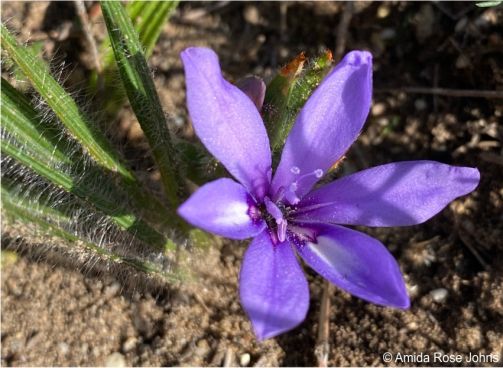
Description
Description
Bobbejaantjies are perennial deciduous cormous geophytes with leaves and flowers that appear seasonally above the ground. Its leaves and stems are shed in anticipation of the dry and hot summer which plants survive due to their corms. Bobbejaantjie roots appear from the base of the corm and are about the same diameter along their length and do not branch. The corms are enveloped in a multi-layered fibrous tunic that sometimes has a netted appearance. A stem arises from the top of the corm that is circular in cross-section, either branching or not, mostly hairy or rough but sometimes smooth, and that may be entirely buried or appear above the ground. The base of the stem is usually surrounded by a collar containing several fibrous layers.
Babiana montana is a small plant, 60-70 mm tall. The leaves are lance-shaped, pleated and hairy. The flowers are mauve with yellow and purple markings. The stamens are unequal, the one being longer than the others, and the stigmas are flattened and orbicular (having a rounded shape). Flowering time is winter and spring (June to August).
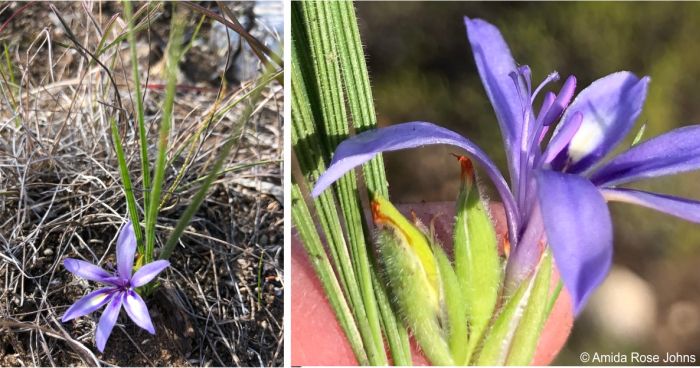
Conservation Status
Status
Babiana montana is assessed as Endangered (EN) according to the SANBI Red List of South African Plants. It is known to occur at just 3 locations and has lost more than 80% of its natural habitat to wheat farming and the remaining populations are at risk because their habitat is being degraded by invasive alien species and overgrazing.
Distribution and habitat
Distribution description
Babiana montana can be found in the Western Cape on the Agulhas Plain, between Caledon and Bredasdorp, where it grows on sandstone and limestone slopes in Renosterveld and Fynbos.
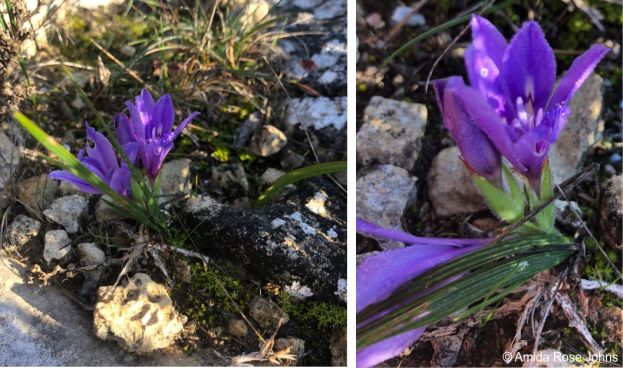
Derivation of name and historical aspects
History
The name Babiana is derived from the vernacular Dutch, baviaantjie, or Afrikaans bobbejaantjie or its Cape corruption babiaantjie, all meaning ‘little baboon’. The baboon, or bobbejaan in Afrikaans, is partial to the corms. The species name montana is from the Latin montanus, meaning ‘relating to mountains’.
Babiana belongs in the Iridaceae family, it is a genus of approximately 92 species most of which occur in Namaqualand and the Western Cape of South Africa. Babiana flowers vary in shape and colour, their brightly coloured and often deliciously spicy, sweetly scented flowers, and attractive pleated leaves make them popular garden ornamentals. Baboon flowers are almost all winter-growing and flower in late winter and spring. The cup shaped blooms are arranged along a spike, and the flowers open successively from the lowest upwards. They come in a range of colours, from blue to mauve and purple, red to pink, and yellow, pure white and cream.
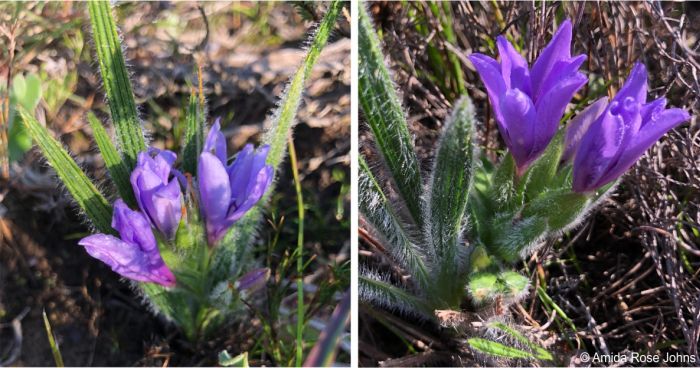
Ecology
Ecology
Babiana montana is a drought tolerant plant, its leaves die back after flowering and the plant becomes dormant during summer, in this way it survives the hot, dry summers of its winter-rainfall habitat. It grows in rocky fynbos and renosterveld in well drained soil, on sandstone and limestone slopes. Most Babiana corms are favoured by baboons as a delicious meal.
Uses
Use
Bobbejaantjies are used as ornamental garden plants and pot plants. The colourful flowers make gardens vibrant and cheerful, providing excellent blooms for the vase. Babiana montana is best for containers or rockeries, and being a small plant, it is best interplanted with similarly short plants so that it does not become overshadowed. Although Babiana montana corms are eaten by baboons, they are not suitable for human consumption.
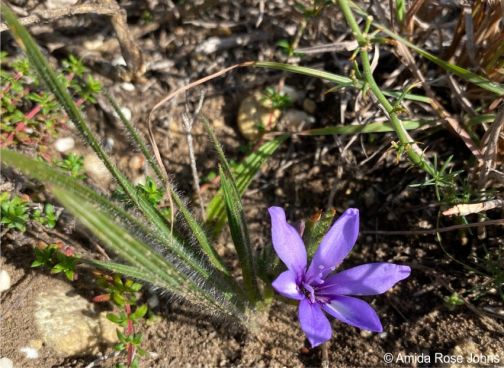
Growing Babiana montana
Grow
Babiana montana can be propagated by seed and division of corms. Division of corms is undertaken by removing the offsets which form on the main plant. Corms are lifted from the soil after flowering, separated, stored in a cool, dry place and planted in autumn. In cold climates where the winter temperature drops to freezing, dig up the corms and store them over the winter season and plant them in spring. Plant the corms 8–10 cm deep with the top of the neck about 3 cm deep, about 5 cm apart, in full sun or partial shade, in well-drained sandy to loamy soil, enriched with decomposed compost. Planting in full sun will encourage flowering.
Seed is sown in autumn, germination will occur in 6 weeks.
Ensure regular watering, keep the corms moist at the root level in winter and spring, but keep dry during summer.
The corm is susceptible to thrips and also red spider mites that mostly attack the leaves. Ensure regular watering, keep the corms moist at the root level in winter and spring, but keep dry during summer. Feeding of the corms should be done once in a month after the corms have started flowering and stopped when the leaves start to die back.
References
- Duncan, G. 2010. Grow bulbs. A guide to the cultivation of bulbs of South Africa and neighboring countries. Kirstenbosch Gardening Series. South African National Biodiversity Institute, Cape Town.
- Eliovson, S. 1980. Wild flowers of southern Africa. MacMillan. Pretoria.
- Goldblatt, P. & Raimondo, D. 2006. Babiana montana G.J.Lewis. National Assessment: Red List of South African Plants version 2020.1. Accessed on 2023/11/01.
- Hobbs, J. & Hatch, T. 1994. Best bulbs for temperate climates. Timber Press, Portland.
- Jackson, W.P.U. 1990. Origins and meanings of names of South African plant genera. University of Cape Town.
- Leistner, O.A. (ed.). 2000. Seed plants of southern Africa: families and genera. Strelitzia 10. National Botanical Institute, Pretoria.
- Manning, J. & Goldblatt, P. 2012. Plants of the Greater Cape Floristic Region 1: the Core Cape Flora. Strelitzia 29. South African National Biodiversity Institute, Pretoria.
- Gardening in South Africa, Baboon Flower, Bobejaantjie – Babiana. https://www.gardeninginsouthafrica.co.za/bulbous-plants/baboonflowerbobbejaantjie-babiana. Accessed 30/10/23.
- Johns, A.R. 2023. Observations of Babiana montana. iNaturalist. Online. https://www.inaturalist.org/observations?place_id=any&taxon_id=560408&user_id=amidarose.
- Smith, C.A. 1966. Common names of South African plants. Memoirs of the Botanical Survey of South Africa No. 35. Government Printer, Pretoria.
Credits
Philisiwe Biyela
Pretoria National Botanical Garden
November 2023
Acknowledgements: the author thanks Thabo Masupa for providing additional information about the plant and Amida Rose Johns for the images.
Plant Attributes:
Plant Type: Bulb
SA Distribution: Western Cape
Soil type: Sandy, Loam
Flowering season: Spring, Winter
PH: Acid, Alkaline, Neutral
Flower colour: Purple, Mauve/Lilac
Aspect: Full Sun
Gardening skill: Average
Special Features:
Horticultural zones








Rate this article
Article well written and informative
Rate this plant
Is this an interesting plant?
Login to add your Comment
Back to topNot registered yet? Click here to register.